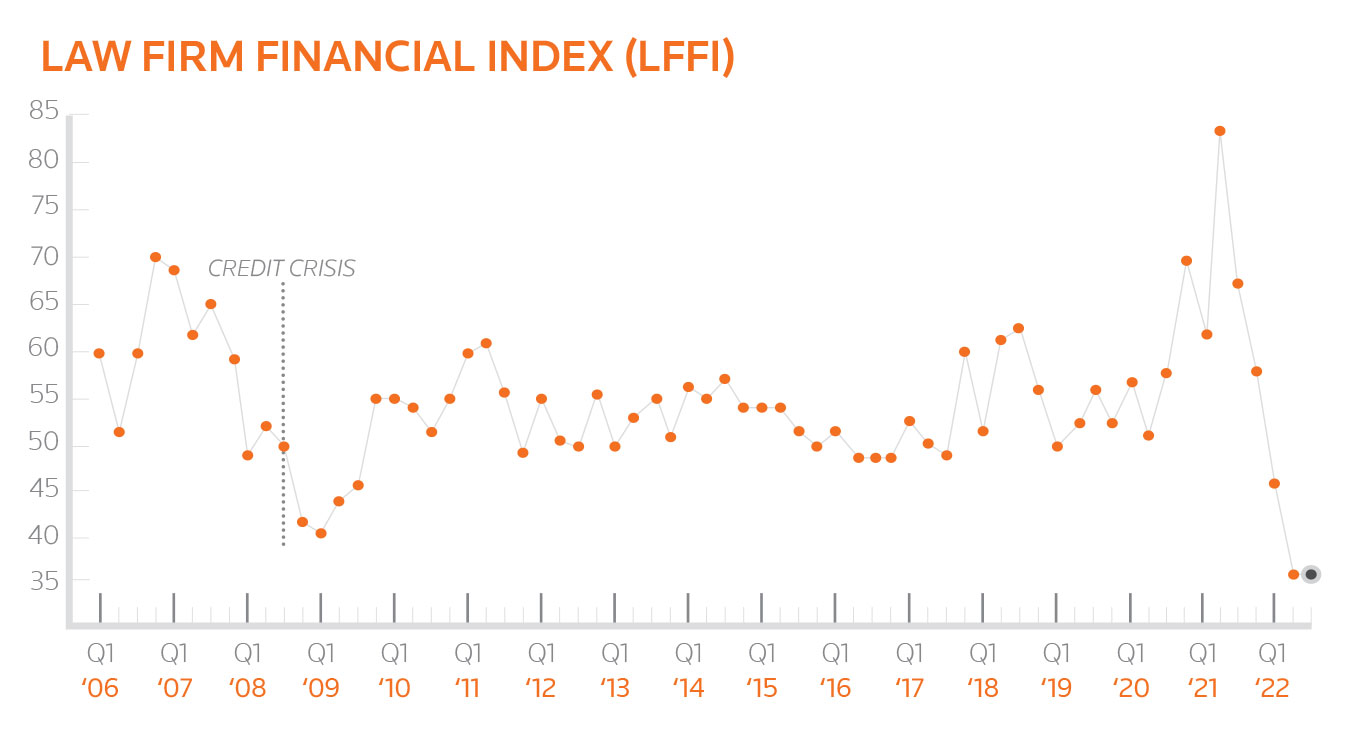In the third quarter, the Thomson Reuters’ Law Firm Financial Index (LFFI) remained at its all-time lowest score, exacerbating concerns for how 2022 will end
For the second consecutive quarter, the Law Firm Financial Index (LFFI) returned to the worst score recorded in the Index’s history. This represents the continuation of a five-quarter fall from the prosperous peaks seen in Q2 of 2021 and gives a strong indication of where law firm profitability is headed.
As we rush towards the end of 2022, this quarter’s number may point to the many difficult decisions facing law firm leaders going into the next year and beyond.
Key takeaways in Q3:
-
-
- Direct and overhead expenses grew at elevated levels;
- Transactional practices continued to contract, especially at the top of the market, while non-transactional work remained flat; and
- Productivity contracted by the largest margin since the beginning of the pandemic.
-
Growing expenses and a dearth in demand were key reasons why the third quarter’s score came in at 36, the exact same score as the second quarter. Once again inflation and return-to-office strategies contributed to growing overhead expenses that continued to vex many law firms. While this quarter saw a slowing of growth compared to the previous quarter, overhead growth rates still remain exceptionally high. Direct expenses, those consisting of compensation and benefits for all attorneys who are not equity partners, experienced a similar slowing, but continued to maintain elevated levels which put additional strain on firms as demand continued to fall.

This fall in demand was primarily driven by shrinking activity in the transactional practices — which includes corporate, tax, and real estate work — most notably in the merger and acquisitions (M&A) practice area. The contractions experienced in these areas has recently had a greater impact on the overall demand as companies leveraged their business more towards transactional work during the pandemic boom times. This, combined with elevated baselines from the previous year, has resulted in poorly performing demand as expenses rise.
The productivity picture
Given this dichotomy between expenses and demand, it was not surprising that productivity dropped to some of its lowest levels seen in recent memory in the third quarter. Indeed, it was particularly worrisome to see such dramatic losses in hours per lawyer. Yet even with productivity’s obvious shortfalls, lawyer growth did not slow, as firms continued their seasonal hiring. Consequently, the decision to cut headcount going forward likely weighs heavily on the minds of many law firm leaders.
All of this combines to paint a bleak portrait for Q3, however there were some positive areas. One area of note was the Midsize law firm segment, which saw demand and revenue grow at the fastest rate in the market, a historical rarity. In the face of falling transactional demand, labor & employment and litigation work proved to be some of the more robust areas of Q3, and many Midsize law firms were able to capitalize on this development.
Another area with a relative positive outlook was rate growth, in which we saw rates grow across the segments at a faster pace than in Q2. These gains, unfortunately, were not enough to overcome inflation and thus the real gains were less than impressive.
Throughout Q3, it seems that firms have decided to weather some short-term losses in this harsh environment in hopes of a more promising future. For now, that promising future sits in the shadow of profit per lawyer (PPL) declines; and this quarter saw the third consecutive slide in PPL.
Even though lawyers still remain more profitable than their pre-pandemic levels, those gains are rapidly dissipating as time runs out in 2022.







